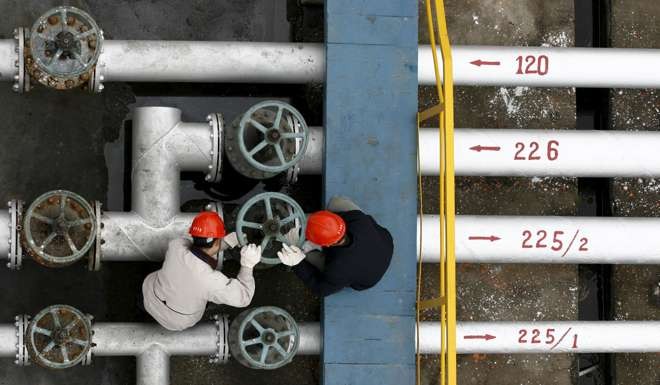
Analysis | More upside expected for oil and gas prices, if OPEC deal delivers as promised
2016 proved to be a salutary lesson: not only has energy outperformed the new economy, but ‘old energy’ has outperformed ‘new energy’
Oil and gas prices are expected to remain on the upside in 2017 after their overall strength surprised analysts in 2016 and analysts now expect the implementation of a supply reduction deal led by oil cartel Organisation of the Petroleum Exporting Countries (Opec) not to disappoint.
The average price of benchmark Brent crude oil averaged US$45 a barrel in 2016, down 17 per cent on 2015 and was 55 per cent below the 2014 average.
But it rebounded strongly from a loss-making average of US$35 in the first quarter of 2016 to US$51 in the fourth quarter, thanks to Opec’s strategy change from one that sought to regain lost market share by sacrificing revenue, back to its traditional tactic of maximising revenue by controlling supply.
“2016 will be remembered as a year full of black swans and contrarian surprises,” said Nomura’s head of Asia oil and gas research Gordon Kwan.
“From Brexit to the Trump election win, to Opec’s stunning policy reversal and the historic pact with non-Opec, the oil price impact is ubiquitous across commodity, foreign exchange, equity and bond markets.”
While the long-term future of energy may belong to renewable energy and electric vehicles, 86 per cent of global primary energy still comes from fossil fuels which remain indispensable to the modern economy
Opec, led by Saudi Arabia which took back its lead position lost in April 2014 from the United States as the world’s largest oil producer, December agreed for the first time in eight years to cut its combined daily output by 1.2 million barrels a day, or 3.5 per cent, in the first half of 2017.
The cartel, which supplies around 35 per cent of global oil supply, together with the world’s third biggest producer Russia, had previously been ramping up production despite falling prices, more than offsetting declines elsewhere, including the higher-cost producer nations of the US, China and Mexico.
To the surprise of market watchers, Opec has also managed to convince some major non-Opec producers – including Russia, Mexico, Oman and Kazakhstan – to agree to a total output cut of 560,000 million barrels a day, for six months from January 1, extendable for another six months.

While the long-term future of energy may belong to renewable energy and electric vehicles, 86 per cent of global primary energy still comes from fossil fuels which remain indispensable to the modern economy
Although low prices forced some of the highest-costing shale oil producers to mothball or cut back on production, low interest rates and ample liquidity meant few went bankrupt and could re-open shut fields once prices rose enough.
The Opec supply cut, if honestly implemented by its members, is expected by analysts to tip the global crude oil market back into deficit and bolster prices in the coming months, after excess inventory is drawn down.
Kwan expects oil price to average US$60 a barrel in 2017, the same as Bernstein Research senior analyst Neil Beveridge’s forecast, and higher than the US$58 projected by RBC Capital Markets. Commodities consultancy Wood Mackenzie has forecast the global oil and gas industry will turn in positive cash flows – with inflows exceeding outflows – for the first time since the downturn began in mid 2014, if oil price averages above US$55 a barrel in 2017.
RBC’s analysts have projected a 96 per cent compliance rate by Opec’s members on their combined output reduction pledge for the first half of 2017, followed by a two to three per cent degradation in the second-half.

Similar to crude oil, natural gas prices’ resilience in 2016 also astounded some experts, despite new projects in Australia adding the largest amount of annual new supply in the history of the liquefied natural gas (LNG) industry.
“2016 was meant to be the year of the global gas glut,” Beveridge said in a note.
“The reason for the better-than-expected performance is that gas demand has been better than expected, helped by lower prices.”
He said China and India both saw LNG imports surge by over 20 per cent in 2016, while Egypt, Pakistan and Jordan provided new unexpected sources of demand, and European and US demand turned out stronger than anticipated.
Beveridge expects Asian LNG prices – usually partially linked to oil prices – to rise to between US$8 and US$9 per million British thermal units in 2017 from US$7.5 in mid December.
He also noted fossil fuels have staged strong price rebounds from the lows early in the year.
They were led by coal’s around 80 per cent surge over the course of 2016 on the back of state-ordered output reduction in China, beating gains of about 50 per cent of oil and natural gas, and a sharp contrast with a 10 per cent decline in lithium carbonate, which powers electric vehicles.
“Not only has energy outperformed the new economy, but ‘old energy’ has outperformed ‘new energy,’” Beveridge added.
“2016 has proved a salutary lesson. While the long-term future of energy may belong to renewable energy and electric vehicles, 86 per cent of global primary energy still comes from fossil fuels which remain indispensable to the modern economy.”

